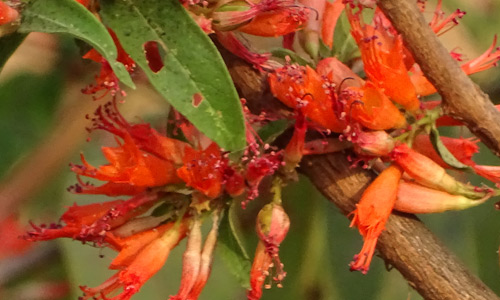|
Division
|
Angiosperms |
|
Class
|
Dicotledons |
|
Subclass |
Polypetalae |
|
Series |
Calyciflorae |
|
Order |
Myrtales |
|
Family
|
Lythraceae |
|
Genus
|
Woodfordia |
|
Species
|
fruticosa |

|
Etymology:
|
In honour of James Woodford (d. 1837). |
|
Botanical name:
|
Woodfordia fruticosa (Linn.) Kurz (Woodfordia floribunda Salisb.) |
|
Local/Trade Names: |
Fire-Flame Bush, Shirannjitea |
|
Conservation status:
|
Commonly found in wild state. |
|
Digonestic features:
|
Flowers orange-red. |
|
Description: |
Evergreen or subdeciduous shrub 1-4 m high; bark reddish – brown, smooth. Leaves opposite, lanceolate or oblong – lanceolate, 4 – 10 x 2-4 cm, rounded at base. Flowers orange – red, 1 – 2 cm long, clustered. Capsule ellipsoid, 8 – 10 mm long, enclosed within the calyx tube; seeds many, brown. |
|
Phenology: |
Fls.: Feb. – April. Frts.: April – June. |
|
Distribution:
|
Submontane Himalaya China, Pakistan, tropical Africa & Madagascar. |
|
Where to see it: |
Ornamental Flowering Section & Medicinal Plant Garden. |
|
Uses: |
Flowers yield a red dye; twigs and leaves also used in dyeing. Flowers also contain tannin. Leaves contain 12-20% tannin and may be exploited for production of tan extracts. Bark contains 20-27% tannin and is used for tanning crust leathers. Dried flowers astringent and stimulant. Commercially available drug consists of dried fruits, flowers, buds and broken pieces of inflorescences and much used in bowel complaints, hemorrhages, menorrhagia, and seminal weakness. Wood suitable for axe-handles, but mostly used as fuel. Yields a gum which resembles gum tragacanth and swells up in water. It is employed for coating the part of the fabric which is not to be dyed. Flowers are used for making a cooling drink. |
Chief Conservator of Forests & Chief Wildlife Warden is the Head of the Department. There is one post of Conservator of Forests & two posts of Deputy Conservator of Forests viz.